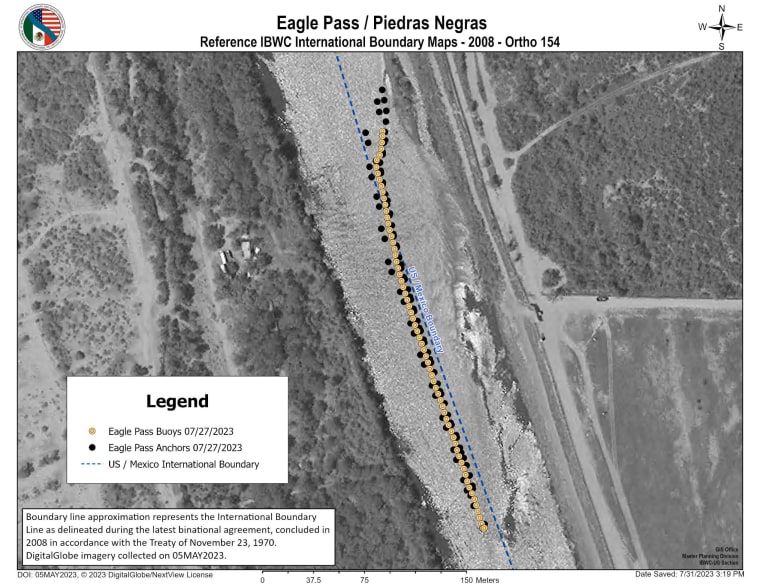Texas' leaders have declared that the state is experiencing an "invasion" of people at the border, but a U.S.-Mexico agency says the state is the one doing the invading.
A document filed by the Department of Justice in its lawsuit against Texas over buoys the state placed in the Rio Grande to deter migrants says that 787 feet of them are in Mexico. Another 208 feet are in the U.S. The section of buoys in U.S. waters are upstream, and the rest are downstream, the document states.

The Rio Grande serves as the boundary between the U.S. and Mexico.
The apparent trespassing was determined through a topographic survey conducted by the International Boundary and Water Commission, according to an affidavit filed in a U.S. government lawsuit against Texas and Gov. Greg Abbott over the buoys.
A page of the court document shows a line of orange dots marking the buoys, black dots marking the buoys' anchors and a dashed line representing the boundary over a topographical photo of the riverbed. Most of the dots are across the dashed line, on the Mexican side.
The Justice Department sued Texas after Abbott launched the buoys last month near Eagle Pass, Texas/Piedras Negras, Mexico, as part of the state's own immigration enforcement system.
Abbott, a Republican, has blamed President Joe Biden for spikes in the number of people arriving at the border or who have crossed it illegally, although there were spikes in migration numbers during the Trump administration and illegal border crossings dipped in June.
The boundary and water commission is a U.S.-Mexico body created in 1889 to apply the terms of boundary and water treaties between the two countries as well as to resolve any differences.
Mexican Foreign Minister Alicia Bárcena said during a visit to Washington this month that Texas' buoys had crossed the border and most were on the Mexican side of the river, which Mexico calls the Rio Bravo, the Dallas Morning News reported.
In earlier filings, the state has said that it's not in violation of treaties and laws governing the river boundary because it has placed the buoys in shallow water, and under the treaty the barrier has to disrupt the navigability of the water to be in violation, the Morning News reported.
Abbott has maintained that his state-run immigration enforcement system is saving lives and property, and preventing an influx of illegal drugs. Critics, however, have said the entire operation is a political ploy to win points with conservatives and runs afoul of federal law that gives the federal government jurisdiction over immigration enforcement.
NBC News has reached out the governor's office for comment.
Mexico and civil rights groups have lashed out at Texas over the buoys, saying they are dangerous and possibly deadly for migrants.
Rep. Joaquín Castro, a Democrat from San Antonio, recently visited the border and examined the buoys. He criticized Abbott's immigration operation as "barbaric" and pointed out the presence of metal disks with jagged edges, what he said appeared to be saw blades, between the buoys.
Abbott, though, appears to be relishing the attention the buoys and the clash with Mexico, Texas' largest trading partner, and the federal government is bringing him and the state.

